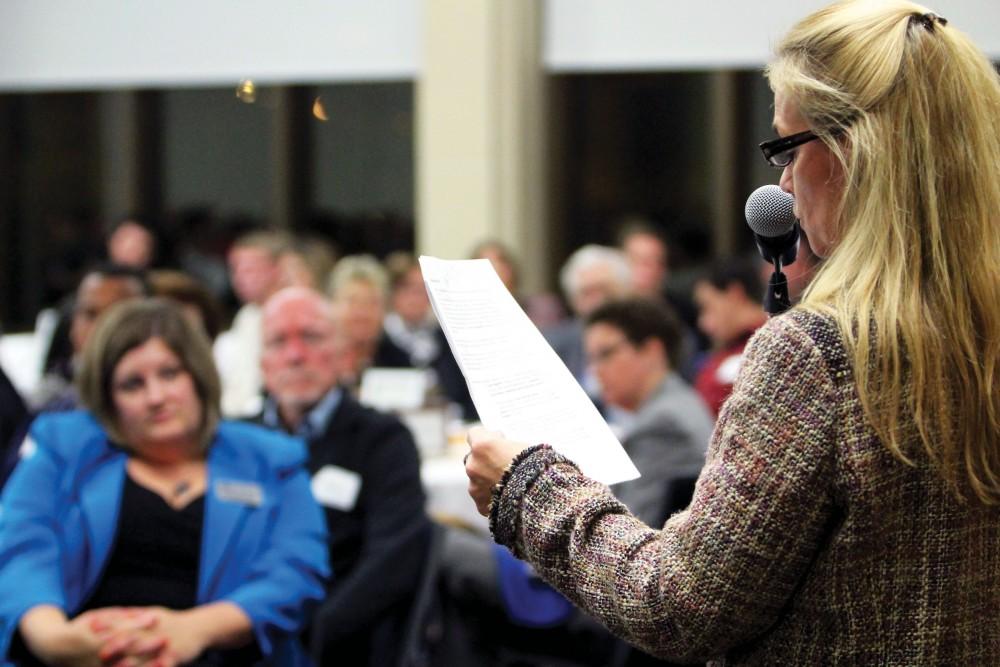Evaluating educators

GVL / Emily Frye Professor Lisa Perhamus
Sep 21, 2015
Each college and university across the nation has an evaluation process in which students rate their professors and courses. At Grand Valley State University, students may have noticed that these forms and the questions are different for different classes, even within the same department.
Karen Gipson,chair of the University Academic Senate, said that when she first came to the university, she was surprised to learn that there were multiple evaluation forms in use.
After more than 10 years of faculty discussions regarding the current evaluation process, Gipson and the UAS approved the creation of a task force called the Universal Student Evaluation of Teaching Implementation. USETI is made up of faculty, staff and students.
“In January 2014, UAS passed a motion for the university to adopt a university-wide system and appointed a task force to decide what that would be,” Gipson said. “We chose the IASystem as being the best for Grand Valley. This new system, I think, is going to be a big improvement for everybody.”
Gipson explained that the new system has four summative questions and the rest are formative questions. The first four allow students to evaluate the effectiveness of their professors. The other questions require a written, open-ended response about the course. These questions are tailored to each class format, with different questions for lab, lecture and discussion courses.
USETI will recommend that the new evaluations are completed in the classroom but are made available on smartphones, tablets and computers.
“We hope that by doing this we get better response rates,” Gipson said. “If students want to have their voices heard, they need to fill out the evaluations. Students’ inputs have weight.”
The UAS chose GVSU mathematics professor Edward Aboufadel as the USETI chair. Aboufadel said his duties include scheduling and leading meetings, writing reports and recommendations and presenting to faculty and deans.
Aboufadel emphasized that how students fill out the form matters, because the information is used when professors are up for tenure, raises and contract renewal. The completed forms go to the faculty member, the department head and the chair. All three of them review and discuss the results.
“This is part of a long-term evolution on campus to continue to improve,” Aboufadel said. “Students can look forward to the same types of questions in all their courses.”
He added that there is a firewall in place to keep students’ responses anonymous online.
Benjamin Lockerd has taught English at GVSU for 30 years and has seen how effective student evaluations are in informing his teaching practices.
In the English department, the evaluations are given on scantron sheets, which have spaces on the back for written comments. Lockerd said these evaluations are kept on file for five years.
“At Grand Valley, the faculty are evaluated in three main areas: teaching, scholarship and service,” Lockerd said. “Teaching is the most important area.”
He said the written comments are the most helpful, because students offer suggestions for how to improve the course. However, Lockerd added that some of them are predictable complaints that he tends to discount, such as “This course is too hard” or “It’s hard to get an A.”
“It shouldn’t be something that you take for granted,” Lockerd said. “If you have a professor who’s not doing a good job, if you put that in the evaluations, that will not be ignored. That gives students a responsibility too. If there’s a problem, we want to know about it, but don’t go after a professor because you could really damage someone’s career.”
Students and faculty can look for the unveiling of the new Laker Impressions of Faculty Teaching evaluation forms beginning in winter 2016.
For more information about the task force, visit www.gvsu.edu/useti/. To learn more about the new system, go to www.iasystem.org.

























